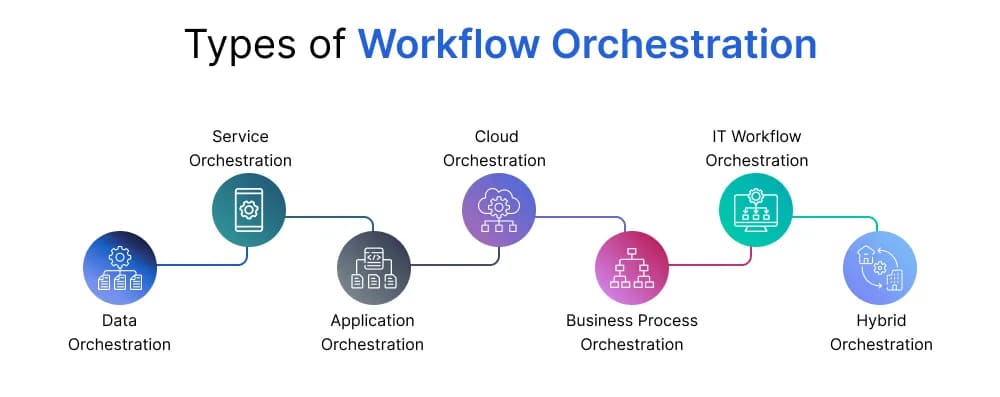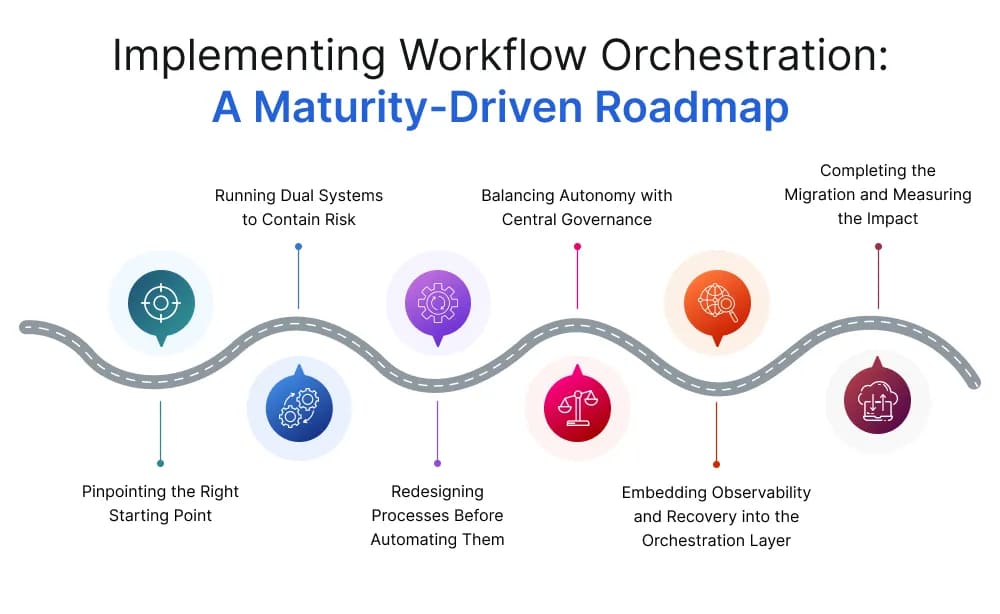
Behind every seamless customer experience, every lightning-fast product release, and every synchronized system integration lies something most people never see: workflow orchestration. It may not be flashy or visible every day. Still, it represents the state every high-functioning organization aspires to reach, where processes run seamlessly, systems stay in sync, and teams operate without friction, even as complexity scales.
Consider this:
Your teams are juggling dozens of tools. Tasks move across people, platforms, and pipelines. And somewhere along the way, priorities get misaligned, steps get skipped, and momentum gets lost.
| As Jeff Bezos put it: “In today’s era of volatility, there is no other way but to reinvent. The only sustainable advantage you can have over others is agility.”Orchestration is how organizations build that agility, at scale. |
The work doesn’t just need to be done; it needs to be done in the right order, by the right systems, at the right time, without you having to micromanage it.
That’s exactly what workflow orchestration delivers.
This guide will take you from the fundamentals of orchestration to its enterprise-wide impact. Whether you’re managing cloud-based microservices, streamlining human approvals, or integrating AI-powered processes across departments, workflow orchestration is how modern organizations stay resilient, scalable, and in control.
Ready to see how it works and why it’s now essential for high-functioning operations? Let’s begin.
What is Workflow Orchestration?
Efficiency isn’t just about doing things faster; it’s about doing them smarter, together, and at scale. That’s where workflow orchestration comes in.
Workflow orchestration is the end-to-end coordination of automated tasks, systems, data, and human actions across complex processes. It’s not just about streamlining one task or process; it’s about architecting how all those tasks come together, execute in harmony, and adapt dynamically to changes.
| It has also become a major enterprise priority; the global workflow orchestration market is expected to grow from $34 billion in 2024 to nearly $94 billion by 2033, reflecting a 11.6% compound annual growth rate.
That growth signals a clear shift: orchestration is no longer a technical back-end function; it’s becoming the connective tissue of modern operations. |
Unlike simple automation, which focuses on completing individual tasks in isolation, workflow orchestration focuses on how those tasks interact, respond to one another, and contribute to the bigger picture. It allows businesses to define the sequence, logic, dependencies, and timing of each step, ensuring that workflows not only run smoothly but also run intelligently and consistently.
In an era where business processes span dozens of tools, systems, and teams, orchestration acts as the central command layer, stitching together everything from a CRM trigger to a backend system update, from an AI model output to a human approval stage.
The power of orchestration lies in its ability to:
- Synchronize multiple workflows across platforms
- Adapt dynamically based on real-time inputs or failures
- Ensure compliance and visibility across every step
- Minimize friction between tools, teams, and data silos
Whether it’s automating a product launch process, managing customer onboarding, or synchronizing DevOps pipelines, workflow orchestration consolidates scattered tasks into a unified, repeatable system with significantly less manual oversight and far greater reliability.
Types of Workflow Orchestration
Workflow orchestration takes many forms, depending on the complexity of processes, the diversity of systems, and the outcomes an organization is aiming to achieve. In modern enterprises, no single orchestration approach can cover every operational need; instead, businesses use a combination of orchestration types, each designed for a specific context.
From synchronizing multi-cloud environments to linking customer touchpoints, from managing data pipelines to coordinating security responses, these orchestration models ensure that every moving part works in harmony. Understanding the distinctions between them isn’t just a technical detail; it’s the foundation for choosing the right orchestration strategy, avoiding siloed automations, and ensuring processes scale without losing control.
Below are ten distinct categories of workflow orchestration, each playing a critical role in different layers of enterprise operations.
1. Data Orchestration
Data orchestration is the discipline of managing how data moves, transforms, and integrates across multiple systems so that it’s always ready for operational or analytical use.
It’s not just about shifting data from Point A to Point B. It’s about ensuring quality, timing, and context, so that by the time the data reaches a dashboard, a machine learning model, or a compliance report, it’s already cleaned, validated, and aligned to business needs.
In complex organizations, data orchestration operates like the traffic control system of a city. It directs data flows from different “roads” (databases, APIs, SaaS tools) to their destinations without collisions, delays, or bottlenecks.
| According to IDC, businesses lose up to 30% of potential revenue when they can’t make data available to the right people at the right time. Data orchestration directly addresses this gap. |
This becomes critical in an era where:
- Data is scattered across cloud platforms, on-prem servers, and edge devices.
- AI and analytics depend on real-time, accurate input.
- Regulatory compliance demands transparent, traceable data flows.
Data orchestration isn’t just about moving data; it’s about making data business-ready. Whether it’s real-time inventory updates, cross-platform marketing insights, or automated compliance checks, orchestration turns scattered data into synchronized action.
2. Application Orchestration
Think of application orchestration as the conductor turning a stack of separate apps into a symphony. It doesn’t just automate individual steps like deployment; it binds tasks, configurations, and tools into unified, reliable flows across platforms.
In practice, it uses APIs, connectors, and scripts to align logic and sequence, whether you’re onboarding a customer across CRM, billing, support tools, or deploying workloads across cloud and on-prem environments.
As enterprises adopt hybrid architectures, application orchestration becomes strategic, helping teams move faster, stay compliant, and deliver dependable services.
| According to Verified Market Reports, the application orchestration services market grew to $3.5 billion in 2024 and is forecast to reach $10.2 billion by 2033, reflecting a strong 12.9% CAGR. |
App orchestration isn’t just about automation—it’s about reliability, scalability, and making hybrid operations manageable. It’s the control center on which agile and resilient application delivery depends.
Case Study – Microservices Deployed at Netflix Scale
Scenario
A global streaming provider needed to run ML-powered personalization workflows in real time as user activity and content constantly changed. Managing dozens of interdependent microservices, covering content ingestion, metadata tagging, and recommendations, had become error-prone and slow.
Solution
Using Netflix’s open-source Conductor engine, the company mapped dependencies, automated retries, and monitored workflows end-to-end. Each service was orchestrated in the correct sequence, with real-time dashboards flagging failures instantly.
Outcome
The orchestration layer cut deployment errors by 40%, enabled near real-time recommendation updates, and allowed new microservices to be integrated seamlessly, ensuring a consistently smooth, personalized experience for millions of users worldwide.
3. Cloud Orchestration
Cloud orchestration coordinates and automates the provisioning, scaling, and management of workloads across public, private, and hybrid cloud environments. Unlike basic cloud automation, which focuses on single tasks, orchestration links those tasks into end-to-end workflows, ensuring policies, dependencies, and cost controls are embedded from the start.
For enterprises, this means faster service delivery, optimized infrastructure usage, and seamless integration between on-premises systems and cloud-native platforms. It also reduces the operational overhead of managing complex, multi-cloud deployments, freeing teams to focus on innovation rather than manual provisioning.
Case Study – Financial Services Firm Cuts Costs and Speeds Innovation
A leading financial services enterprise was running critical business applications across 1,500 servers in mixed infrastructure setups. Provisioning was slow, operational costs were high, and managing workloads across multiple environments lacked standardization.
Solution
The company implemented a unified cloud orchestration platform that integrated AWS-hosted applications with its on-premises data center. A self-service provisioning portal was introduced, with deployment zones aligned to enterprise policies for cost efficiency. Automation tools streamlined the full application lifecycle, and a structured migration factory approach ensured smooth workload transitions.
The Impact
- 40% reduction in infrastructure costs
- 40% faster time-to-market for new products and services
- 200% improvement in application performance
- Achieved ROI in under three years
4. Service Orchestration
Service orchestration ensures seamless coordination of network services across multiple domains, physical hardware, virtual elements, legacy systems, and modern cloud infrastructure.
| According to industry insights, up to 95% of network modifications in telecom environments are still performed manually, resulting in operational costs that are two to three times higher than those with automated orchestration. |
Unlike task-based orchestration, service orchestration aligns diverse technologies, manages dependencies, and delivers unified services through a single control plane. This approach is essential in telecom, where services span SDN, NFV, public/private clouds, and on-prem networks.
Case Study – Multi-Domain Service Orchestration for a Networking Equipment Supplier
Overview
A US-based global telecom equipment supplier (~$3?billion revenue) faced delays in service integration due to fragmented multi-vendor and hybrid infrastructure.
Solution
ACL Digital built a multi-domain service orchestration platform, including:
- Resource Adaptors (RA) for systems like OpenStack, AWS, Juniper, Nuage, vCenter, ONAP
- A centralized self-service portal enabling on-demand configuration across AWS, cloud, and data center environments.
- Support for end-to-end service chaining, EPL/EVPL, L3VPN, audits, and bulk modifications, all automated using MDSO templates and REST-based services
Outcomes
- Unified visibility and provisioning across hybrid and multi-vendor domains
- Modular platform enhanced flexibility and simplified service deployment
5. Business Process Orchestration
Business Process Orchestration goes beyond automating isolated tasks; it’s about weaving them into a cohesive, logic-driven flow that connects departments, systems, and stakeholders. The goal is simple: ensure that every process runs end-to-end with speed, accuracy, and complete visibility.
Orchestration isn’t just technology; it’s strategic. McKinsey found that digitizing information?intensive business processes can cut costs by up to 90% and accelerate turnaround times by orders of magnitude. This level of transformation powerfully positions orchestration as a competitive advantage.
Key Applications of Business Process Orchestration
1. Onboarding Employees – From Paperwork to Productivity
Employee onboarding involves multiple handoffs between HR, IT, legal, and facilities teams. With orchestration, this becomes a single, connected workflow:
- Trigger: HR enters the hire details into the central system.
- Automated actions: Notifications to legal for contract compliance, IT for account setup and device allocation, and facilities for workspace preparation.
- Outcome: New hires are fully equipped and integrated into the company’s systems on day one, without bottlenecks or missed steps.
2. Compliance and Risk Management – Guardrails Built Into the Process
Maintaining compliance is no longer about periodic audits; it’s about embedding compliance checks into the workflow itself.
With orchestration:
- Processes align with regulatory frameworks (e.g., GDPR, HIPAA, SOX).
- Automated control tests run on schedule.
- Risk events are detected and flagged instantly, triggering remediation workflows.
Result: Compliance becomes a continuous, proactive activity rather than a reactive scramble.
6. IT Workflow Orchestration
IT Workflow orchestration coordinates the execution of tasks across systems, teams, and tools to ensure they run in the right order, at the right time, and with full visibility. It goes beyond task automation by managing dependencies, handling exceptions, and maintaining logic across diverse business environments, from multi-cloud architectures to on-premise and hybrid setups.
In distributed enterprises, workflows span dozens of platforms and services. Without orchestration, these processes often become fragmented, leading to delays, duplicated work, and higher operational costs. A unified orchestration layer eliminates manual handoffs, standardizes execution, and enables rapid adaptation to change.
Key Benefits
- Accelerated Delivery – Orchestration removes integration bottlenecks, reducing deployment cycles by up to 45%.
- Cost Optimization – Streamlines multi-cloud operations and reduces infrastructure overhead by 20–30%.
- Improved Reliability – Centralized monitoring and automated error handling cut downtime and boost service quality.
- Resource Efficiency – Frees IT teams from repetitive maintenance work, allowing focus on innovation and strategic initiatives.
Case Study – Spotify’s Migration to Kubernetes
Challenge: Spotify’s rapid growth and adoption of microservices created operational complexity, making its in-house orchestration system, Helios, difficult to scale.
Solution: The company transitioned 150 services to Kubernetes, running it in parallel with Helios to minimize disruption.
Outcome: Deployment tasks that once took hours were completed in minutes, operational costs dropped, and engineering teams gained the agility to deliver features faster while aligning with industry best practices.
7. Hybrid Orchestration
Hybrid orchestration integrates workflows across both on-premise and cloud environments, creating a unified execution layer for complex, distributed processes. It eliminates the gap between legacy infrastructure and cloud-native platforms, enabling seamless automation, policy enforcement, and visibility across all environments.
| According to Gartner, over 75% of mid-to-large enterprises have adopted multi-cloud strategies as of 2023, highlighting the growing trend towards hybrid and multi-cloud environments. |
Key Capabilities
- Unified Control Plane: Centralized governance for workflows regardless of execution location.
- Dynamic Routing: Automatically runs tasks on the most cost-effective or performant infrastructure.
- Cross-Platform Visibility: End-to-end monitoring and SLA tracking across all environments.
Case Study – Global Retail Supply Chain on Hybrid Orchestration
Scenario:
A global retail giant operated critical ERP systems in its data centers for compliance reasons while running e-commerce and analytics platforms on AWS and Azure. Seasonal surges, multiple sales channels, and real-time inventory management made manual coordination between these environments highly error-prone.
Solution:
The company implemented a hybrid orchestration platform that connected its on-prem ERP, warehouse automation systems, AWS analytics services, and Azure-based customer engagement tools. Orders placed online triggered automated workflows that:
- Checked inventory in the on-prem ERP.
- Updated order status across both ERP and cloud-based order management systems.
- Routed customer updates and tracking information via cloud messaging services.
Outcomes:
- Order fulfillment time reduced by 35% during peak shopping seasons.
- Inventory accuracy improved by 28%, reducing overselling incidents.
- Unified visibility for operations and IT teams, enabling faster exception handling.
Implementing Workflow Orchestration: A Maturity-Driven Roadmap
Implementing workflow orchestration isn’t just about adopting a new tool; it’s about reshaping how work flows across your organization. To make this practical, let’s walk through one real orchestration journey, Spotify’s migration from its in-house Helios platform to Kubernetes, and use it to understand the end-to-end implementation process. Along the way, we’ll highlight best practices you can apply to any orchestration rollout, regardless of your industry or tooling.
Phase 1 – Pinpointing the Right Starting Point
When Helios began hitting its limits in 2017, Spotify didn’t simply throw everything into Kubernetes at once. Instead, they mapped their entire microservices landscape, noting service dependencies, update frequency, and criticality to business operations.
The first orchestration candidates were high-velocity, high-dependency services like music playback APIs and recommendation engines, the heartbeat of the Spotify user experience. These were complex enough to stress-test Kubernetes but not so intertwined that a failure would take down the entire platform.
| Best Practice
Before you choose a workflow to orchestrate, evaluate:
This deliberate scoping prevents the “big bang” failure that many orchestration projects suffer from. |
Phase 2 – Running Dual Systems to Contain Risk
Spotify knew that orchestration is not a “switch over and hope” exercise. For over a year, they ran Helios and Kubernetes in parallel.
This dual-run strategy gave them:
- Controlled migration – Moving services one at a time instead of in bulk
- Live benchmarking – Comparing how both systems handled identical workloads
- Instant rollback safety – If Kubernetes faltered, they could redirect traffic back to Helios immediately
An example of this safety net in action: during early tests, a misconfigured autoscaling rule caused Kubernetes to spin up unnecessary containers, spiking infrastructure costs. Because the service was still active in Helios, Spotify engineers switched traffic back in seconds, fixed the rule, and retried.
Phase 3 – Redesigning Processes Before Automating Them
Rather than cloning Helios workflows into Kubernetes, Spotify cleaned house first. They:
- Removed duplicate approval steps that slowed releases
- Standardized deployment environments to avoid “works on my machine” issues
- Consolidated custom scripts into reusable, centrally managed templates
Orchestration is force-multiplication. If you automate a messy process, you’ll amplify the mess. Spotify’s approach meant Kubernetes orchestrated leaner, cleaner pipelines from day one.
| For a finance team implementing invoice processing orchestration, this could mean first removing redundant checks, digitizing paper-based inputs, and unifying approval rules. So, orchestration is built on a solid foundation. |
Phase 4 – Balancing Autonomy with Central Governance
Spotify operates through hundreds of independent engineering squads. Kubernetes’ API-driven orchestration allowed these squads to customize deployments for their unique needs – for example, personalizing scaling rules for a music recommendation service versus an ad-tracking service.
However, central governance wasn’t abandoned. The platform team enforced:
- Baseline security standards (TLS everywhere, role-based access)
- Scaling boundaries to avoid cost blowouts
- Consistent logging formats for observability
This balance gave teams freedom without chaos.
Phase 5 – Embedding Observability and Recovery into the Orchestration Layer
From the first Kubernetes deployment, Spotify embedded:
- Real-time metrics dashboards for CPU, memory, and request latency
- Health checks that triggered automated rollbacks if error rates spiked
- Centralized logs to trace issues across multiple services in seconds
In one case, an update to the playlist service caused response latency to triple. The orchestration layer caught it within minutes, rolled the service back, and alerted the squad, avoiding widespread user frustration.
| Implementation takeaway: Observability and recovery aren’t “add later” features. They should be part of the orchestration design itself so problems are detected and resolved before customers feel the pain. |
Phase 6 – Completing the Migration and Measuring the Impact
By 2019, over 150 core Spotify services had moved to Kubernetes. The results:
- Deployment times dropped from hours to under 10 minutes
- Incident response times improved thanks to integrated rollback and monitoring
- Innovation speed increased, teams could experiment and ship new features faster without waiting on central ops
Crucially, the orchestration project was judged not just on technical success but on business outcomes: faster time-to-market for new features, better platform stability during peak usage, and improved developer productivity.
| Pro Tip: Always tie orchestration metrics back to business KPIs – speed, cost, reliability, and customer experience. Without this, orchestration risks being seen. |
Challenges and Considerations in Workflow Orchestration
Workflow orchestration promises seamless execution and automation across your organization’s most vital processes, but the path to achieving this isn’t without its challenges. Beneath the surface of automation and optimization lie some real-world complexities that can affect both the implementation and long-term value of your orchestration initiative.
Let’s explore what those are, not as a checklist, but as realities that shape your orchestration journey.
1. The Architecture Is as Complex as the Process Itself
One of the earliest hurdles that appears when automating a single task is mapping the actual process. In theory, workflows sound linear, but in practice, they involve branching logic, parallel execution, error handling, dynamic conditions, and dependencies that aren’t always obvious until they fail. Designing workflows that reflect real business behavior (and not just ideal scenarios) takes time, cross-team input, and iteration. It’s not just a technical job; it’s organizational introspection.
2. Orchestration Isn’t Cheap – At First
Costs can accumulate quickly when setting up a workflow orchestration framework, including platform licenses, integration specialists, infrastructure upgrades, compliance planning, and ongoing training. While the long-term ROI can be significant, orchestration doesn’t always offer an instant payback, especially if it’s applied to inefficient processes that haven’t been optimized beforehand. Teams must justify orchestration with measurable value cases or risk it being perceived as overengineering.
3. Not Everyone Is Ready to Change
Introducing orchestration often requires dismantling deeply rooted manual processes. This can meet silent resistance from teams who have spent years perfecting their own “workarounds” or fear being automated out of relevance. Adoption isn’t just about onboarding users; it’s about changing mindset. Leaders must frame orchestration as augmentation, not displacement, and ensure that the shift is inclusive and aligned with actual needs, not just IT directives.
| 90% of CEOs believe the digital economy will impact their industry, but less than 15% are executing on a digital strategy. |
4. IT and Business Still Speak Different Languages
Orchestration lives at the intersection of technology and business intent, but these two groups often move at different speeds. Business users want agility, control, and fast iteration. IT teams prioritize system integrity, governance, and scalability. Misalignment between these expectations can lead to overcomplicated workflows or underwhelming delivery. Effective orchestration needs collaboration, not handoffs.
5. Legacy Systems Don’t Play Along Easily
You can’t orchestrate what you can’t access. Many organizations run critical operations on legacy systems that don’t support APIs or modern integration patterns. These systems weren’t built with orchestration in mind, which means bridging technologies or workarounds are often required. The effort to connect these dots must be weighed against the operational gain; sometimes, modernization needs to happen in parallel.
6. Security Is Built Into Every Connection
With every new integration, every API trigger, and every data handoff, your surface area for risk expands. Sensitive data might be moving between internal tools, external services, and cloud infrastructure, all automatically. Without strict access controls, audit trails, and encryption policies, orchestration can introduce vulnerabilities faster than it eliminates inefficiencies. And with regulations tightening, compliance can’t be treated as a final step.
7. A Necessary Complexity – Not a Flaw
All these challenges are not barriers to avoid; they’re elements to anticipate, plan for, and navigate through. Workflow orchestration works best not when it’s perfect but when it’s realistic: built with an understanding of where friction exists, where people matter, and where systems need to evolve gradually.
Done right, orchestration becomes less about forcing automation and more about designing flow within processes, between people, and across your enterprise architecture.
Conclusion
Workflow orchestration has evolved from a behind-the-scenes IT function to a core business capability, enabling organizations to unify processes, eliminate gaps, and respond faster to change. From customer onboarding to managing complex multi-cloud environments, orchestration brings structure, speed, and intelligence to operations.
Real-world examples, like Spotify’s migration to Kubernetes, show that success hinges on more than technology alone; it requires clear objectives, thoughtful design, stakeholder alignment, and continuous optimization. When done right, orchestration doesn’t just streamline work; it transforms how teams collaborate and innovate.
At Invensis Learning, we help professionals and enterprises build these capabilities through our training. Our programs blend practical frameworks, hands-on exercises, and real-world case studies to ensure your orchestration initiatives deliver measurable impact.
















